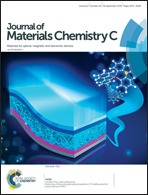Extremely low-efficiency roll-off of phosphorescent organic light-emitting diodes at high brightness based on acridine heterocyclic derivatives†
Abstract
Three novel host materials, IpCm-PhBzAc (1,3-(4-(12,12-dimethylbenzofuro[3,2-b]acridin-7(12H)-yl)phenyl)-6-isopropyl-4H-chromen-4-one), DpAn-BzAc (2,10-(4-(12,12-dimethylbenzofuro[3,2-b]acridin-7(12H)-yl)phenyl)-10-phenylanthracen-9(10H)-one) and DpTrz-BphBzAc (3,7-(4′-(4,6-diphenyl-1,3,5-triazin-2-yl)-[1,1′-biphenyl]-4-yl)-12,12-dimethyl-7,12-dihydrobenzofuro[3,2-b]acridine) have been designed and synthesized, and their utilization as host materials for phosphorescent organic light-emitting diodes (PhOLEDs) has been investigated. We have fabricated PhOLEDs using green bis(2-phenylpyridine)iridium(III) acetylacetonate as doped emitters and two hosting schemes, which are the single host system consisting of BzAc derivatives and the co-host system with 1,3-bis(carbazolyl)benzene. We found that the PhOLEDs with the co-host system of DpAn-BzAc and DpTrz-BphBzAc achieved CEs of 57.1 cd A−1 and 53.0 cd A−1, with corresponding efficiency roll-off of only 7.6% and 0.9%, respectively, from the maximum to the practical brightness of 5000 cd m−2. Extremely reduced efficiency roll-off values for BzAc-based PhOLEDs were attributed to their superior thermal stability and excellent bipolar transport properties, and a small singlet–triplet energy gap also afforded efficient reverse intersystem crossing, thus reducing the triplet density of the host for PhOLEDs.



 Please wait while we load your content...
Please wait while we load your content...
